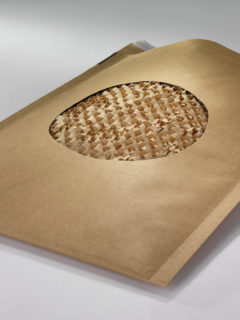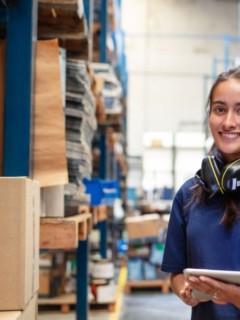There are a number of different types of packing tape to choose from. In this article, we look at the differences between different types of tape and give advice on when it’s best to use each type. By choosing the right tape for your needs, your parcels will be better sealed and your goods will be less likely to be damaged in transit.
What is packing tape made of?
To choose the right packing tape, it can be useful to know the different components of a tape. A tape usually consists of two parts – carrier and adhesive. The carrier is the material of the tape itself and the adhesive is the type of glue used. Some types of tape, mainly PP tape, also have a so-called release that sits on the outside of the carrier and allows it to be easily unrolled without sticking, and a layer of primer that sits between the carrier and the adhesive and ensures that the two fit together properly.
In this article, we’ll look at the two most important parts – the carrier and the type of adhesive – to help you decide which is best for you. The most common packing tapes are PP (polypropylene) tape, PVC (polyvinyl chloride) tape and paper tape. PP tape can have three different adhesives: hot melt, acrylate or natural rubber. PVC tape and paper tape come in different qualities and thicknesses, but always use natural rubber as an adhesive.
Which packing tape should you choose?
There are several factors to consider when choosing a packing tape: the material the boxes are made of, the weight of the contents, the number of boxes to be packed, how they will be transported and stored, and how important it is that the tape is as environmentally friendly as possible.
The answer to these questions will determine which packing tape is best for you: PP, PVC or paper tape.
PP tape – a versatile tape in different varieties

- PP tape hotmelt: The most economical choice
HotmeltPP tape is suitable for those who do not pack many or heavy boxes. The hotmelt adhesive makes the tape make noise during use, but it is the most cost-effective option. The tape is easy to roll out.
- Low-noise PP tape
PP tape with acrylate is available in different thicknesses of plastic and adhesive, meaning it can be used for both light and heavy boxes. Acrylic PP tape is quiet when unrolled and is also suitable if the box may be exposed to higher temperatures. Low noise PP tape is recommended to be used instead of PVC tape when there are environmental requirements.
PVC tape – the classic packing tape

PVCtape has a slightly duller surface than PP tape and medium to slow roll-out.
It is favourably used for heavier boxes and is suitable for single, double and triple corrugated cardboard. It is quiet in use. PVC tape can be used in damp and cold environments, but application at room temperature is recommended. Suitable for transport as it can withstand shock loads due to the PVC tape having high breaking strength and high tensile strength. This means that it does not stretch and can therefore withstand more movement on, for example, a pallet during transport.
Tip: Want to colour code the boxes while taping?
Then choose coloured PVC packing tape. And do you want to use packing tape to inform about fragile contents? Then choose warning tape made of PVC with standard print such as “Be careful”.
Remember, however, that PVC is a poorer choice for the environment, so use with caution. Other types of packing tape are better environmental choices and should be used wherever possible.
Paper tape – best for the environment

Paper packing tape is best for the environment and does not need to be removed from the box when recycling.
RAJA’s paper tape consists of unbleached kraft paper with self-adhesive natural rubber as an adhesive. It has a medium fast unrolling speed. Paper tape can be torn off by hand and has high tensile strength. It is available in different paper thicknesses and for really heavy packages you can choose rubberised paper tape. These are sealing strips of pure kraft paper that have an odourless adhesive that is activated with water. This cannot be removed from the box without leaving obvious marks, so it prevents shrinkage during transport. If you choose this tape, you should also buy a manual or electronic tape dispenser with a water reservoir, which moisturises and cuts the tape strips. Watch the video below to see how it’s done.
Read also: Guide to masking tape and different types of paper tape
Fibreglass tape – perfect for export
Fibreglass tape is a PP packing tape that is reinforced with longitudinal fibreglass strands. The adhesive is hot melt. This is the tape for those who pack really heavy products. The tape can be used outdoors and is perfect for export deliveries.

Choose tape with natural fibre adhesive for recycled boxes
Boxes come in many different types and formats. Today, the corrugated cardboard from which boxes are made is often made of so-called recycled fibres/testliner, i.e. recycled material. Currently, it is usually said that paper fibres can be recycled up to seven times before the fibres become too short for use, but new research shows that it may be possible to recycle, with high quality, up to 25 times! There are also boxes that have recycled fibres on the inside of the box and “new” fibres/kraftliner on the outside. New fibres then come from brand new pulp. This combination of different papers usually results in a slightly stronger box. You can also get boxes made with only kraftliner/new fibres. If you are unsure about the quality of your boxes, feel free to contact us at RAJA.
For boxes with recycled fibres, tape with natural rubber as an adhesive is recommended, as it adheres better to the substrate. The most common tapes are PVC or paper tape. PP hot melt works on smaller, lightweight boxes. If the boxes are made of new fibres, you can use any type of tape and adhesive, depending more on the size and weight of the contents.
What is the best way to tape a box?
To seal a box in the best possible way you should choose:
- U-shaped closure for boxes up to 20kg with short or light transport distance.
- For boxes up to 40kg, a combined U- or L-shaped closure is recommended.
- The H-shaped closure is suitable for large and heavy boxes over 40kg that are to be stored for long periods of time or transported over long distances.

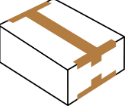
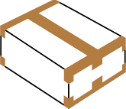
With the right tape, you don’t have to “over-tape” the box, which you might do if you’re unsure of how the tape will behave. By using the right sealing method depending on the contents of the parcel and the transport distance, you will prevent unnecessary waste of packing tape when securing the parcel.
PS. Want to pack even faster and easier? Check out our Easybox with automatic bottom and adhesive strip.
How should packing tape be stored?
Packing tape should be stored lying down, at an even temperature between 12-23 degrees and in the dark.
Keep the tape in its packaging to protect it from dust. Be sure to use the oldest tape first as the tape has a limited shelf life. If the tape gets too hot or cold, leave it at room temperature for 24 hours before using it.
How to design your own packing tape?
With the Rajaprint tool, you can design and order your own labelled packing tape online.
Delivery time is 6-8 weeks, but can vary. If you buy a larger volume, you get a better price. We help you step by step throughout the process.

Customised packaging tape is today one of the most common ways to market/brand your company. By labelling your boxes or e-commerce bags with the tape, you secure your packaging while strengthening your brand. In the unlikely event that your shipment goes astray, it will also be easier to identify.
While the most common packaging tape is still printed on a plastic tape, paper tape with its eco-friendly appearance has recently become popular as an alternative. Paper tape is available in both brown and white (creamy white) colours, but the brown version is the most popular. Here you need to think about the colours of the print as you can’t expect exactly the same result as on a plastic tape. But a monochrome black print on a brown paper tape looks great!
Below you can see a couple of examples of tapes that some of RAJA’s customers have had produced.
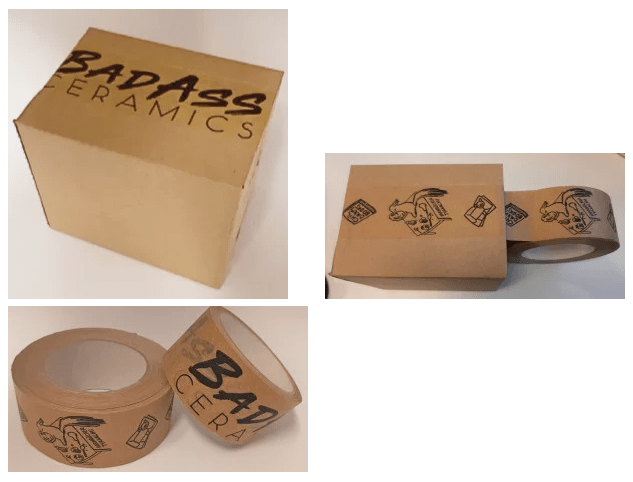
Glossary of terms
| Testliner | Paper made from recycled paper that has been tested to meet certain strength requirements. Testliner, which is intended to form a surface layer on corrugated board, is an alternative to kraftliner, which is made from pure sulphate pulp. |
| Kraftliner | A paper mould containing at least 80% virgin pulp. Kraftliner is used for the surface layer of corrugated board (if made from recycled corrugated board, it is called testliner) |
| Paper tape | Tape made from unbleached kraft paper from renewable resources and is recyclable. Can be recycled together with the box. Self-adhesive natural rubber |
| PP tape | Tape made from polypropylene. This is a plastic material that is also used in the production of many household products such as bowls, packaging etc. Traditionally considered a more environmentally friendly plastic as fewer chemical additives are used in its production. Available with different types of adhesives. Recycled as plastic. |
| PVC tape | Tape made of polyvinyl chloride. The material PVC is one of the most controlled and regulated substances as it was previously considered a “more dangerous” type of plastic. Nowadays, its production is highly regulated, for example through the sustainable use of additives and not least through the active involvement of the European manufacturing industry. Self-adhesive natural rubber. Recycled as plastic. |











